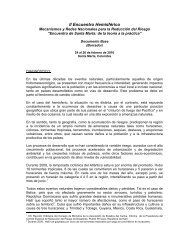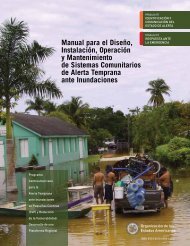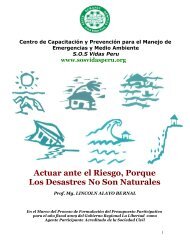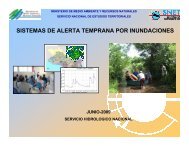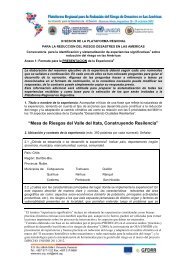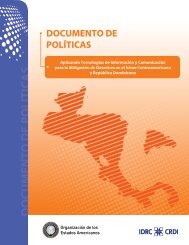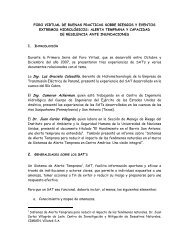Early Warning Systems in the context of Disaster Risk ... - unisdr
Early Warning Systems in the context of Disaster Risk ... - unisdr
Early Warning Systems in the context of Disaster Risk ... - unisdr
You also want an ePaper? Increase the reach of your titles
YUMPU automatically turns print PDFs into web optimized ePapers that Google loves.
<strong>Early</strong> <strong>Warn<strong>in</strong>g</strong> <strong>Systems</strong> <strong>in</strong><br />
<strong>the</strong> <strong>context</strong> <strong>of</strong> <strong>Disaster</strong> <strong>Risk</strong><br />
Management<br />
People-centred early<br />
warn<strong>in</strong>g systems<br />
empower communities<br />
to prepare for and<br />
confront <strong>the</strong> power <strong>of</strong><br />
natural hazards.<br />
However, <strong>the</strong> efficiency<br />
<strong>of</strong> such systems is to be<br />
measured <strong>in</strong> terms <strong>of</strong><br />
lives saved and<br />
reduction <strong>in</strong> losses,<br />
which is directly related<br />
to <strong>the</strong> execution <strong>of</strong> an<br />
anticipated response by<br />
<strong>the</strong> people and<br />
<strong>in</strong>stitutions once a<br />
warn<strong>in</strong>g is issued. This<br />
paper addresses<br />
traditional views on<br />
early warn<strong>in</strong>g systems,<br />
and what it takes to<br />
transform <strong>the</strong>m <strong>in</strong>to<br />
efficient, people-centred<br />
systems.<br />
Countries have long been concerned<br />
about <strong>the</strong> huge impacts that natural<br />
disasters have on society <strong>in</strong> developed<br />
and especially <strong>in</strong> develop<strong>in</strong>g<br />
countries. Unfortunately, societies have<br />
not adapted <strong>the</strong>ir frameworks <strong>of</strong> development<br />
to <strong>the</strong> natural environment surround<strong>in</strong>g<br />
<strong>the</strong>m and <strong>the</strong> losses and costs<br />
associated with disasters <strong>of</strong> natural orig<strong>in</strong>.<br />
On <strong>the</strong> contrary societal catastrophes<br />
are grow<strong>in</strong>g by <strong>the</strong> decade; global<br />
annual disaster costs <strong>of</strong> fifty billion US<br />
dollars are common. Between 1960 and<br />
1990 <strong>the</strong> economic losses <strong>of</strong> disasters<br />
<strong>in</strong>creased five times due to ris<strong>in</strong>g vulnerability<br />
(MunichRe, NatCatSERVICE; Geo<br />
<strong>Risk</strong>s Research, 2005). Our vulnerability to<br />
natural hazards is grow<strong>in</strong>g, because population<br />
<strong>in</strong>creases and more people are<br />
liv<strong>in</strong>g <strong>in</strong> risky places.<br />
Nearly a million people have been killed<br />
over <strong>the</strong> last decade by disasters caused<br />
by storms, droughts, floods. While some<br />
material losses seem to be unavoidable,<br />
especially <strong>in</strong> <strong>the</strong> case <strong>of</strong> very large and<br />
<strong>in</strong>frequent events, <strong>in</strong> some cases <strong>the</strong> loss<br />
<strong>of</strong> human lives could have been avoided if<br />
<strong>the</strong> proper precautions and measures had<br />
been <strong>in</strong> place. This would have been <strong>the</strong><br />
case for <strong>the</strong> December 26, 2004 Indian<br />
Ocean tsunami, which provoked fatalities<br />
surpass<strong>in</strong>g a quarter <strong>of</strong> a million people.<br />
Three phases <strong>of</strong> early warn<strong>in</strong>g systems<br />
Measurement <strong>of</strong><br />
precursors<br />
In Sri Lanka, over 34,000 people lost <strong>the</strong>ir<br />
lives due to <strong>the</strong> lack <strong>of</strong> a tsunami early<br />
warn<strong>in</strong>g system. While <strong>the</strong>re would have<br />
been sufficient time to warn some <strong>of</strong> <strong>the</strong><br />
coastal population, <strong>the</strong> lack <strong>of</strong> awareness<br />
regard<strong>in</strong>g tsunamis, <strong>the</strong> lack <strong>of</strong> an early<br />
warn<strong>in</strong>g system, and <strong>the</strong> lack <strong>of</strong> tra<strong>in</strong><strong>in</strong>g<br />
to respond to a warn<strong>in</strong>g <strong>in</strong>hibited <strong>the</strong><br />
authorities and <strong>the</strong> local population from<br />
execut<strong>in</strong>g <strong>the</strong> proper measures which<br />
would have significantly reduced <strong>the</strong> loss<br />
<strong>of</strong> lives.<br />
The traditional framework <strong>of</strong> early warn<strong>in</strong>g<br />
systems is composed <strong>of</strong> three phases:<br />
monitor<strong>in</strong>g <strong>of</strong> precursors, forecast<strong>in</strong>g <strong>of</strong> a<br />
probable event, and <strong>the</strong> notification <strong>of</strong> a<br />
warn<strong>in</strong>g or an alert should an event <strong>of</strong><br />
catastrophic proportions take place. An<br />
improved four-step framework be<strong>in</strong>g promoted<br />
by national emergency agencies<br />
and risk management <strong>in</strong>stitutions <strong>in</strong>cludes<br />
<strong>the</strong> additional fourth phase: <strong>the</strong><br />
onset <strong>of</strong> emergency response activities<br />
once <strong>the</strong> warn<strong>in</strong>g has been issued. The<br />
purpose <strong>of</strong> this fourth element is to recognize<br />
<strong>the</strong> fact that <strong>the</strong>re needs to be a<br />
response to <strong>the</strong> warn<strong>in</strong>g, where <strong>the</strong> <strong>in</strong>itial<br />
responsibility relies on emergency response<br />
agencies (see figure).<br />
Effective early warn<strong>in</strong>g systems require<br />
strong technical foundations and good<br />
knowledge <strong>of</strong> <strong>the</strong> risks. But <strong>the</strong>y must be<br />
Measurement <strong>of</strong><br />
precursors<br />
Juan Carlos Villagran de León and<br />
Janos Bogardi<br />
United Nations University – Institute for<br />
Environment and Human Security<br />
(UNU-EHS)<br />
Görresstraße 15<br />
53113 Bonn<br />
No<br />
Forecast<br />
<strong>in</strong>dicates<br />
catastrophic<br />
event<br />
Yes<br />
No<br />
Forecast<br />
<strong>in</strong>dicates<br />
catastrophic<br />
event<br />
Yes<br />
Stefanie Dannenmann and Reid Basher<br />
Platform for <strong>the</strong> Promotion <strong>of</strong> <strong>Early</strong><br />
<strong>Warn<strong>in</strong>g</strong> (UN/ISDR)<br />
Görresstraße 30<br />
53113 Bonn<br />
<strong>Warn<strong>in</strong>g</strong><br />
<strong>Warn<strong>in</strong>g</strong><br />
Onset <strong>of</strong><br />
Antipated Response<br />
entwicklung & ländlicher raum 2/2006<br />
23
Schwerpunkt<br />
strongly «people centred» – with clear<br />
messages, dissem<strong>in</strong>ation systems that<br />
reach those at risk, and practiced and<br />
knowledgeable responses by risk managers<br />
and <strong>the</strong> public. Public awareness<br />
and education are critical; <strong>in</strong> addition,<br />
many sectors must be <strong>in</strong>volved. Effective<br />
early warn<strong>in</strong>g systems must be embedded<br />
<strong>in</strong> an understandable manner and relevant<br />
to <strong>the</strong> communities which <strong>the</strong>y<br />
serve.<br />
The four elements <strong>of</strong> peoplecentred<br />
<strong>Early</strong> <strong>Warn<strong>in</strong>g</strong> <strong>Systems</strong><br />
A complete and effective, people-centred<br />
early warn<strong>in</strong>g system – EWS – comprises<br />
four <strong>in</strong>ter-related elements, spann<strong>in</strong>g<br />
knowledge <strong>of</strong> hazards and vulnerabilities<br />
through to preparedness and capacity to<br />
respond. A weakness or failure <strong>in</strong> any one<br />
<strong>of</strong> <strong>the</strong>se elements could result <strong>in</strong> failure <strong>of</strong><br />
<strong>the</strong> whole system. Best practice EWS also<br />
have strong <strong>in</strong>ter-l<strong>in</strong>kages between all elements<br />
<strong>in</strong> <strong>the</strong> cha<strong>in</strong>.While good governance<br />
and appropriate <strong>in</strong>stitutional arrangements<br />
are not specifically represented on<br />
<strong>the</strong> «four element diagram», <strong>the</strong>y are critical<br />
to <strong>the</strong> development <strong>of</strong> effective early<br />
warn<strong>in</strong>g systems. Good governance is<br />
encouraged by robust legal and regulatory<br />
frameworks and supported by long term<br />
political commitment and <strong>in</strong>tegrated <strong>in</strong>stitutional<br />
arrangements. Major players concerned<br />
with <strong>the</strong> different elements should<br />
meet regularly to ensure that <strong>the</strong>y understand<br />
all <strong>of</strong> <strong>the</strong> o<strong>the</strong>r components and<br />
what o<strong>the</strong>r parties need from <strong>the</strong>m.<br />
Centralisation and decentralisation <strong>of</strong> EWS<br />
When analyz<strong>in</strong>g who executes <strong>the</strong> two <strong>in</strong>itial phases <strong>of</strong> <strong>the</strong> early warn<strong>in</strong>g systems,<br />
namely, monitor<strong>in</strong>g and forecast<strong>in</strong>g, one can see two trends, centralised systems<br />
where a national-type agency carries out <strong>the</strong>se functions, and decentralised systems<br />
where <strong>the</strong>se tasks are carried out by o<strong>the</strong>r agencies, municipal workers and volunteers<br />
at <strong>the</strong> more local level. For example, <strong>in</strong> Central America, <strong>the</strong> national meteorological<br />
agencies operate early warn<strong>in</strong>g systems for hurricanes and for floods, <strong>in</strong>clud<strong>in</strong>g<br />
<strong>the</strong> emission <strong>of</strong> <strong>the</strong> warn<strong>in</strong>g to <strong>the</strong> media. Such systems are set up and operated<br />
by <strong>the</strong>se <strong>in</strong>stitutions. In contrast, national disaster reduction<br />
agencies, <strong>in</strong>ternational organisations, and non-governmental<br />
organisations have been implement<strong>in</strong>g decentralised systems <strong>in</strong><br />
small bas<strong>in</strong>s, where communities carry out all phases, <strong>in</strong>clud<strong>in</strong>g<br />
<strong>the</strong> response. In such systems, city halls are coord<strong>in</strong>at<strong>in</strong>g most <strong>of</strong><br />
<strong>the</strong> activities, and are connected to <strong>the</strong> national emergency<br />
agency via a radio network that is used to communicate all <strong>in</strong>formation<br />
with<strong>in</strong> <strong>the</strong> system.<br />
While decentralised systems operate us<strong>in</strong>g much simpler equipment<br />
and are thus less precise, such systems rely on a network <strong>of</strong><br />
people-operated radios to transmit <strong>in</strong>formation regard<strong>in</strong>g precursors<br />
to events or warn<strong>in</strong>gs. The trade <strong>of</strong>f ga<strong>in</strong>ed from los<strong>in</strong>g<br />
precision to monitor and forecast events is ga<strong>in</strong>ed by be<strong>in</strong>g able<br />
to transmit o<strong>the</strong>r very useful <strong>in</strong>formation, generally related to<br />
social issues, such as medical needs, <strong>in</strong>formation regard<strong>in</strong>g relatives<br />
or processes, or <strong>the</strong> solution <strong>of</strong> such problems as <strong>the</strong> fix<strong>in</strong>g<br />
<strong>of</strong> power l<strong>in</strong>es when <strong>the</strong>y fail, or acquir<strong>in</strong>g heavy mach<strong>in</strong>ery to reopen<br />
a road which might be blocked by a landslide. So far, community-operated<br />
systems have been mostly applied <strong>in</strong> <strong>the</strong> case<br />
<strong>of</strong> floods, especially <strong>in</strong> small flood bas<strong>in</strong>s.<br />
24<br />
<strong>Risk</strong> Knowledge. <strong>Risk</strong>s arise from both <strong>the</strong><br />
hazards and <strong>the</strong> vulnerabilities that are<br />
present. What are <strong>the</strong> patterns and trends<br />
<strong>in</strong> <strong>the</strong>se factors <strong>Risk</strong> assessment and<br />
mapp<strong>in</strong>g will help to set priorities among<br />
early warn<strong>in</strong>g system needs and to guide<br />
preparations for response and disaster<br />
prevention activities. <strong>Risk</strong> assessment<br />
could be based on historic experience and<br />
human, social, economic and environmental<br />
vulnerabilities.<br />
<strong>Warn<strong>in</strong>g</strong> Service. A sound scientific basis<br />
for predict<strong>in</strong>g potentially catastrophic<br />
events is required. Constant monitor<strong>in</strong>g <strong>of</strong><br />
possible disaster precursors is necessary<br />
to generate accurate warn<strong>in</strong>gs on time.<br />
Approaches that address many hazards<br />
and <strong>in</strong>volve various monitor<strong>in</strong>g agencies<br />
are most effective.<br />
Communication and Dissem<strong>in</strong>ation. Clear<br />
understandable warn<strong>in</strong>gs must reach<br />
those at risk. For people to understand <strong>the</strong><br />
warn<strong>in</strong>gs <strong>the</strong>y must conta<strong>in</strong> clear, useful<br />
<strong>in</strong>formation that enables proper responses.<br />
Regional, national and community level<br />
communication channels must be identified<br />
<strong>in</strong> advance and one authoritative<br />
voice established.<br />
Response Capability. It is essential that<br />
communities understand <strong>the</strong>ir risks; <strong>the</strong>y<br />
must respect <strong>the</strong> warn<strong>in</strong>g service and<br />
should know how to react. Build<strong>in</strong>g up a<br />
prepared community requires <strong>the</strong> participation<br />
<strong>of</strong> formal and <strong>in</strong>formal education<br />
sectors, address<strong>in</strong>g <strong>the</strong> broader concept <strong>of</strong><br />
risk and vulnerability.<br />
Challenges fac<strong>in</strong>g<br />
<strong>Early</strong> <strong>Warn<strong>in</strong>g</strong> <strong>Systems</strong><br />
In January 2004 <strong>the</strong> UN Secretary-General<br />
called for Global <strong>Early</strong> <strong>Warn<strong>in</strong>g</strong> <strong>Systems</strong><br />
(EWS) address<strong>in</strong>g all natural hazards. In<br />
his 21 March 2005 Report on <strong>the</strong> implementation<br />
<strong>of</strong> <strong>the</strong> Millennium Declaration,<br />
«In Larger Freedom: towards development,<br />
security and human rights for all»,<br />
he requested <strong>the</strong> secretariat for <strong>the</strong> International<br />
Strategy for <strong>Disaster</strong> Reduction<br />
(ISDR secretariat) to coord<strong>in</strong>ate a survey<br />
<strong>of</strong> <strong>the</strong> world’s early warn<strong>in</strong>g capacities<br />
and gaps. The complete results <strong>of</strong> <strong>the</strong> survey<br />
will be published some time <strong>in</strong> 2006<br />
but prelim<strong>in</strong>ary f<strong>in</strong>d<strong>in</strong>gs highlight some<br />
<strong>of</strong> <strong>the</strong> shortcom<strong>in</strong>gs <strong>of</strong> EWS (UN/ISDR<br />
2005).<br />
Different hazards require different early<br />
warn<strong>in</strong>g systems: <strong>the</strong> needs for <strong>the</strong><br />
warn<strong>in</strong>g <strong>of</strong> a drought or a tsunami, for<br />
example, are very different. Experiences<br />
ga<strong>the</strong>red around <strong>the</strong> world show that<br />
some hazards are difficult to predict.<br />
For example, <strong>the</strong> forecast <strong>of</strong> catastrophic<br />
eruptions or tsunamis <strong>in</strong> any part <strong>of</strong><br />
<strong>the</strong> world is still fac<strong>in</strong>g major difficulties<br />
due to <strong>the</strong> lack <strong>of</strong> adequate measur<strong>in</strong>g<br />
techniques to capture <strong>the</strong> true<br />
magnitude and tim<strong>in</strong>g regard<strong>in</strong>g <strong>the</strong>se<br />
potentially catastrophic events. Never<strong>the</strong>less,<br />
efforts are underway to<br />
advance such knowledge and improve<br />
<strong>the</strong> precision <strong>of</strong> such forecasts.<br />
At present, many systems that are able<br />
to issue warn<strong>in</strong>gs for a number <strong>of</strong> natural<br />
hazards are <strong>in</strong> place. A frequent<br />
problem, however, is <strong>the</strong> weak l<strong>in</strong>kage<br />
between <strong>the</strong> technical capacity to issue<br />
<strong>the</strong> warn<strong>in</strong>g and <strong>the</strong> public’s capacity<br />
to respond effectively to <strong>the</strong> warn<strong>in</strong>g,<br />
i.e., <strong>the</strong> capacity <strong>of</strong> <strong>the</strong> warn<strong>in</strong>g to trigger<br />
<strong>the</strong> appropriate response by emergency<br />
management agencies, community-based<br />
organizations and <strong>the</strong> public<br />
at large. Moreover, <strong>the</strong> understand<strong>in</strong>g<br />
by <strong>the</strong> public and community organiza-<br />
entwicklung & ländlicher raum 2/2006<br />
Photo: UNU
The four elements <strong>of</strong> people-centred <strong>Early</strong> <strong>Warn<strong>in</strong>g</strong> <strong>Systems</strong><br />
<strong>Risk</strong> knowledge<br />
Prior knowledge <strong>of</strong> <strong>the</strong> risks<br />
faced by communities.<br />
Are <strong>the</strong> hazards and <strong>the</strong><br />
vulnerabilities well known<br />
What are <strong>the</strong> patterns and<br />
trends <strong>in</strong> <strong>the</strong>se factors<br />
Are maps and data<br />
widely available<br />
Dissem<strong>in</strong>ation<br />
Dissem<strong>in</strong>ation <strong>of</strong> understandable<br />
warn<strong>in</strong>g to those at risk.<br />
Do <strong>the</strong> warn<strong>in</strong>gs reach<br />
those at risk<br />
Do people understand<br />
<strong>the</strong> warn<strong>in</strong>gs<br />
Do <strong>the</strong>y conta<strong>in</strong> relevant<br />
and useful <strong>in</strong>formation<br />
tions <strong>of</strong> <strong>the</strong>ir risk and vulnerabilities is<br />
<strong>of</strong>ten lack<strong>in</strong>g. Therefore, preparedness<br />
programmes as well as land use and<br />
urban plann<strong>in</strong>g, public education and<br />
awareness programmes are needed.<br />
Different hazards are handled widely<br />
differently. Wea<strong>the</strong>r-related hazards are<br />
generally well covered worldwide<br />
through <strong>the</strong> national meteorological<br />
and hydrological services <strong>of</strong> <strong>the</strong> WMO<br />
system, and forecast accuracy has<br />
improved greatly over recent decades.<br />
These capacities still need to be extended<br />
to o<strong>the</strong>r hazards and complemented<br />
by o<strong>the</strong>r risk reduction measures that<br />
are sorely miss<strong>in</strong>g, as was well illustrated<br />
by <strong>the</strong> Indian Ocean tsunami<br />
tragedy.<br />
Many develop<strong>in</strong>g countries, <strong>in</strong> particular<br />
<strong>the</strong> least developed among <strong>the</strong>m,<br />
have limited capacities for effective<br />
early warn<strong>in</strong>g systems, and <strong>in</strong> some<br />
cases <strong>the</strong>y are virtually non-existent.<br />
Key requirements appear to be <strong>the</strong><br />
development <strong>of</strong> national <strong>in</strong>tegrated<br />
risk reduction and risk management<br />
capabilities, and improved technical<br />
equipment and tra<strong>in</strong><strong>in</strong>g.<br />
By consider<strong>in</strong>g hazards and vulnerabilities<br />
toge<strong>the</strong>r with a view to reduc<strong>in</strong>g<br />
risk, it should be possible to <strong>in</strong>crease<br />
<strong>the</strong> effectiveness with<strong>in</strong> <strong>in</strong>stitutions,<br />
<strong>the</strong> efficiency <strong>of</strong> outgo<strong>in</strong>g actions, and<br />
public preparedness for early warn<strong>in</strong>g<br />
systems to be effective.<br />
<strong>Warn<strong>in</strong>g</strong> service<br />
Technical monitor<strong>in</strong>g and<br />
warn<strong>in</strong>g service.<br />
Are <strong>the</strong> right parameters<br />
be<strong>in</strong>g monitored<br />
Is <strong>the</strong>re a sound scientific basis<br />
for mak<strong>in</strong>g forecasts<br />
Can accurate and timely<br />
warn<strong>in</strong>gs be generated<br />
Response capability<br />
Knowledge and preparedness to<br />
act by those threatened.<br />
Do communities<br />
understand <strong>the</strong>ir risks<br />
Do <strong>the</strong>y respect <strong>the</strong><br />
warn<strong>in</strong>g service<br />
Do <strong>the</strong>y know how to react<br />
Are plans up to date<br />
and practiced<br />
Conclusions<br />
The challenges that have been presented<br />
will require susta<strong>in</strong>ed attention by Governments.<br />
The 2004 tsunami disaster also<br />
gave additional relevance to <strong>the</strong> work <strong>of</strong><br />
<strong>the</strong> World Conference on <strong>Disaster</strong> Reduction<br />
(WCDR, Kobe, Hyogo, Japan, 18-22 January<br />
2005), and <strong>the</strong> bluepr<strong>in</strong>t agreed by<br />
Governments dur<strong>in</strong>g <strong>the</strong> Conference, <strong>the</strong><br />
Hyogo Framework for Action 2005-2015.<br />
The Framework carries a strong commitment<br />
and ownership <strong>of</strong> Governments and<br />
regional, <strong>in</strong>ternational and non-governmental<br />
organizations. The emphasis <strong>of</strong> <strong>the</strong><br />
Framework on national implementation<br />
and follow-up, with <strong>the</strong> primary responsibility<br />
<strong>of</strong> states, requires <strong>the</strong> development <strong>of</strong><br />
strong participatory and collaborative ties<br />
between civil society and authorities at<br />
national and local levels, <strong>in</strong>volv<strong>in</strong>g all development<br />
sectors (health, education, agriculture,<br />
tourism, etc.), national disaster management<br />
systems, bus<strong>in</strong>ess sector and academic,<br />
scientific and technical support<br />
organisations. Some gaps, such as tsunami<br />
early warn<strong>in</strong>g systems, that are now clearly<br />
identified still require significant capacity<br />
build<strong>in</strong>g efforts. An even greater effort is<br />
required for o<strong>the</strong>r less visible threats. The<br />
International <strong>Early</strong> <strong>Warn<strong>in</strong>g</strong> Conference III<br />
to be held <strong>in</strong> Bonn at <strong>the</strong> end <strong>of</strong> March,<br />
2006, will surely provide ample opportunity<br />
to identify advances <strong>in</strong> <strong>the</strong>se critical<br />
areas as well as advances <strong>in</strong> exist<strong>in</strong>g systems<br />
and approaches to early warn<strong>in</strong>g.<br />
Indigenous knowledge and education<br />
Reports from around <strong>the</strong> Indian Ocean rim<br />
after <strong>the</strong> December 26 tsunami, such as<br />
from fish<strong>in</strong>g communities <strong>in</strong> Thailand,<br />
tribal communities on India’s remote Andaman<br />
and Nicobar islands (Perez, F.Y.L.,<br />
2005 Survival Tactics <strong>of</strong> Indigenous People:<br />
http://academic.evergreen.edu/g/grossmaz/LEEPERFY/),<br />
and even tourist resorts<br />
powerfully demonstrate that knowledge<br />
ga<strong>in</strong>ed from experience or from education<br />
are critical to reduc<strong>in</strong>g disasters.<br />
Leaders <strong>of</strong> Indonesia’s Simeulue community<br />
received a prestigious U.N. award for<br />
sav<strong>in</strong>g tens <strong>of</strong> thousands <strong>of</strong> lives dur<strong>in</strong>g<br />
<strong>the</strong> tsunami. Thanks to faith <strong>in</strong> <strong>the</strong>ir own<br />
knowledge <strong>of</strong> how <strong>the</strong> sea behaves and<br />
<strong>the</strong> reaction <strong>of</strong> buffaloes ahead <strong>of</strong> <strong>the</strong><br />
tsunami, this community <strong>of</strong> some 80,500<br />
people fled <strong>the</strong> shore for nearby hills on<br />
that fateful Sunday morn<strong>in</strong>g. Consequently,<br />
only seven people died from <strong>the</strong> tsunami<br />
<strong>in</strong> this island community, while 163,795<br />
died across <strong>the</strong> rest <strong>of</strong> Indonesia’s nor<strong>the</strong>rn<br />
Aceh prov<strong>in</strong>ce (UN/ISDR, 2005, UN<br />
Sasakawa Award for <strong>Disaster</strong> Reduction:<br />
http://www.<strong>unisdr</strong>.org/eng/sasakawa/<br />
2005/sk-2005-description-eng.htm).<br />
«The story <strong>of</strong> what happens to <strong>the</strong> sea<br />
before a tsunami and how <strong>the</strong> buffaloes<br />
rush towards <strong>the</strong> hills has been shared by<br />
families for years along with o<strong>the</strong>r stories<br />
about our ancestors», said Mohamed Ridwan,<br />
a leader <strong>of</strong> <strong>the</strong> Simeulue community,<br />
after receiv<strong>in</strong>g <strong>the</strong> award. This oral narrative<br />
had been shaped by <strong>the</strong> destruction<br />
that shook this community <strong>of</strong> farmers,<br />
fishermen and traders when an earthquake<br />
followed by a tsunami hit <strong>the</strong><br />
islanders <strong>in</strong> 1907, kill<strong>in</strong>g thousands. «S<strong>in</strong>ce<br />
<strong>the</strong>n we have learned how to escape, and<br />
last December it took about 30 m<strong>in</strong>utes to<br />
get to <strong>the</strong> higher ground», Ridwan, 53, secretary<br />
<strong>of</strong> <strong>the</strong> Simeuleu district region, expla<strong>in</strong>ed<br />
dur<strong>in</strong>g an <strong>in</strong>terview.<br />
The power <strong>of</strong> knowledge was also demonstrated<br />
at a tourist resort near Phuket,<br />
Thailand, where a young British schoolgirl<br />
recognised that <strong>the</strong> turbulent sea and loud<br />
noise <strong>of</strong> <strong>the</strong> waves meant a tsunami was<br />
com<strong>in</strong>g (Cl<strong>in</strong>ton, B., Transcript <strong>of</strong> Remarks<br />
to UN Economic and Social Council<br />
(ECOSOC), July 14th 2005: http://www.<br />
<strong>unisdr</strong>.org/eng/media-room/po<strong>in</strong>tview/WJC-ECOSOC-transcript.pdf).<br />
She<br />
alerted her parents and o<strong>the</strong>r people present<br />
<strong>of</strong> <strong>the</strong> danger, which possibly resulted<br />
<strong>in</strong> sav<strong>in</strong>g <strong>of</strong> 100 lives. The girl was able to<br />
recognise <strong>the</strong> signs because she had<br />
recently learned about tsunamis <strong>in</strong> classes<br />
at her school. Education, whe<strong>the</strong>r <strong>of</strong> formal<br />
or <strong>in</strong>formal type, empowers people by<br />
provid<strong>in</strong>g a sound basis for understand<strong>in</strong>g<br />
and action.<br />
entwicklung & ländlicher raum 2/2006<br />
25



